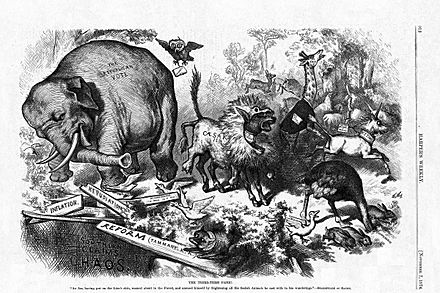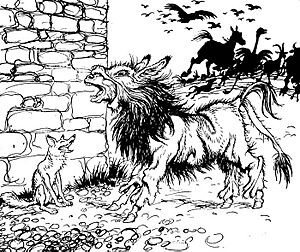The Ass in the Lion's Skin facts for kids
The Ass in the Lion's Skin is a famous story from Aesop's Fables. There are two main versions of this tale, and many similar stories exist in other cultures, especially in the East. The meaning of the story can change depending on the version.
The Fable's Different Versions
One well-known version of this fable is listed as number 188 in the Perry Index, which is a way to catalog Aesop's stories. In this tale, a donkey finds a lion's skin. He puts it on and has fun scaring all the other animals who think he's a real lion.
Finally, the donkey meets a fox. He tries to scare the fox too, but as soon as the fox hears the donkey's loud "bray" (the sound a donkey makes), the fox says, "I might have been scared if I hadn't heard your voice!" The lesson here is often said to be: Clothes might hide who someone really is, but their words will always show their true self. This version is also found in Babrius's collection of fables.
Another version of the story, listed as number 358 in the Perry Index, tells of a donkey who wears a lion's skin so he can eat grass in fields without being bothered. However, his ears stick out from the skin, giving him away. He gets caught and punished. This version, found in ancient Greek writings, was also retold by Avianus in Latin and later by William Caxton. The moral of this story warns against being too proud or pretending to be something you're not.
Many famous writers have mentioned this fable in their works. For example, William Shakespeare used it in his play King John. The French writer La Fontaine also wrote his own version (Fable 5.21) in 1668, which is similar to the second version. La Fontaine's lesson is that you shouldn't judge someone just by how they look, because clothes don't make the person. A modern musical version, Aesop Go HipHop (2012), teaches the message: "Be yourself, don’t hide behind a disguise."
How the Fable is Used Later On

The story of the ass in the lion's skin has been used in many ways over time. In American politics, for example, the famous cartoonist Thomas Nast used this fable in 1874. At that time, people thought that President Ulysses S. Grant might try to run for president a third time, which was unusual.
Around the same time, there was a false news report that animals had escaped from the Central Park Zoo in New York City. Nast combined these two ideas in a cartoon for Harper's Weekly. The cartoon was called "Third Term Panic." It showed a donkey wearing a lion's skin, labeled "Caesarism" (meaning someone acting like a powerful ruler). This fake lion was scaring other animals, which represented different groups of people or interests.
The fable also appeared in children's literature in the 20th century. C.S. Lewis used a similar idea in The Last Battle, which is the final book in The Chronicles of Narnia series. In this story, a donkey named Puzzle is tricked into wearing a lion's skin. He is then used to make simple-minded creatures believe that Aslan, the great lion, has returned to Narnia. Writer Kathryn Lindskoog noted that C.S. Lewis likely got this idea from the Avianus version of the fable.
You can find many old drawings and pictures related to this fable from the 15th to the 20th century by searching online on Flickr.


